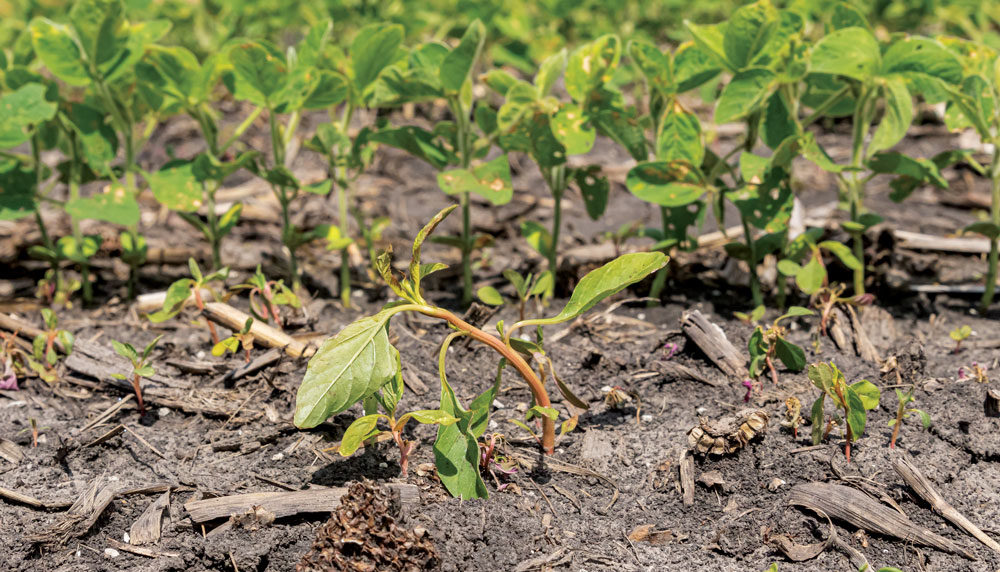Researchers at the University of Illinois have discovered a population of waterhemp that resists the effects of the Dicamba herbicide.
While that’s significant by itself – Dicamba has been widely adapted for use as a weed killer on crops with an engineered immunity – researchers say the more significant development might be the way in which this resistance was developed.
Pat Tranel, a professor in the Department of Crop Sciences, said producers shouldn’t discard any stockpiles of the chemical they might have right now simply because resistance had been recorded in a few groups of plants. University of Tennessee Extension weed specialist Larry Steckel and graduate research assistant Delaney Foster have also confirmed resistant waterhemp in Tennessee, according to a piece they authored in Successful Farming.
“This certainly shows that waterhemp has the ability to evolve resistance to this herbicide,” Tranel said.
However, researchers also discovered another, potentially more far-reaching detail, Tranel said.
“The other interesting twist to this case of resistance is that this waterhemp population came from a field that did not have a history of Dicamba use on it,” he said.
If the waterhemp plants hadn’t seen Dicamba before, how did they know to resist it? While a lot of the specifics aren’t well understood, Tranel said the general mechanism involves the plant’s ability to handle other types of herbicides.
For example, the same group of weeds sparked another investigation about ten years prior, Tranel said. A colleague was called out to investigate the population after reports that the weeds were able to withstand the Group 27 herbicides.
“This population has resistance to several different herbicides that collectively span across six different site of action groups,” he said. “Presumably this population has various enzymes that are able to detoxify a variety of herbicides.”
The weeds have gotten tougher over time.
The development of Dicamba-resistant waterhemp probably came about after other herbicides killed weeds that couldn’t process them, Tranel said. Plants that couldn’t break down herbicides died out and were replaced by the descendants of plants that could resist them.
“Any herbicide selects for enzymes that can detoxify those herbicides,” he said. “The term we use is cross-resistance. The ability to metabolize one herbicide may not be limited to just that herbicide, it may be able to also detoxify other herbicides. And so it's probably the selection by these other herbicides that by chance selected for these enzymes that happened to be able to detoxify not only the herbicides that were used in the population, but also other herbicides that weren't used on the population.”
The resistance is the latest chapter in the odyssey of waterhemp across the corn belt.
In 1913, other members of the same pigweed genus – redroot pigweed and smooth pigweed – were abundant in fields in every county in Iowa, according to an account authored by Iowa State University agronomy professor Bob Hartzler. By contrast, farmers at the time said waterhemp was found along watercourses and in marshes, not in fields, Hartzler wrote. Starting in 1957, scientists noticed that plants west of the Mississippi river were more likely to be weedy, and classified them as a separate species, which was undone in 2001 after a genetic analysis.
Scientists weren’t investigating waterhemp as a cause for concern as recently as 1982. It had showed up as far east as Indiana in the early 1950s, but not at the levels that would cause concern.
However, by the mid-1980s, waterhemp had become a significant problem in central Missouri and parts of Illinois, Hartzler wrote. It spread to Southern Iowa, then to Illinois, Kansas, Nebraska, Minnesota, Wisconsin and the Dakotas. It became a significant concern in Ohio as recently as 2017, according to Hartzler. Steckel and Foster wrote that prior to 2019, waterhemp was rare as far east as Tennessee.
The new resistance – and the way it was developed – could cause both short term and long term issues for herbicide use, Tranel said.
“We don’t understand this well enough to be able to predict what are the different herbicides that these metabolic resistances can confer resistance to,” he said. “And that's the challenge for growers. So in the past, when we had resistance — typically we would have resistance to herbicides within the same site of action — we could tell farmers to rotate herbicides using different sites of action. But with this new type of resistance where it's less predictable, we really can't tell farmers which herbicides they should rotate.”
However, it also has potential ramifications for future herbicide use, Tranel said.
“If you extrapolate this, what this means is these populations are evolving resistance to herbicides that haven't even been commercialized yet,” he said. “So that's kind of a scary thought, right? It’s harder and harder for companies to come up with new herbicides. And now you add on top of that, they may come up with a new herbicide and lo and behold, the weed population is already resistant to it.”
The development underscores the need for producers to diversify weed attack strategies, Tranel said.
“It points back to another reason why we're going to keep using herbicides, but let's do more integration of other strategies in addition to those herbicides to help preserve those herbicides,” he said.








Post a comment
Report Abusive Comment